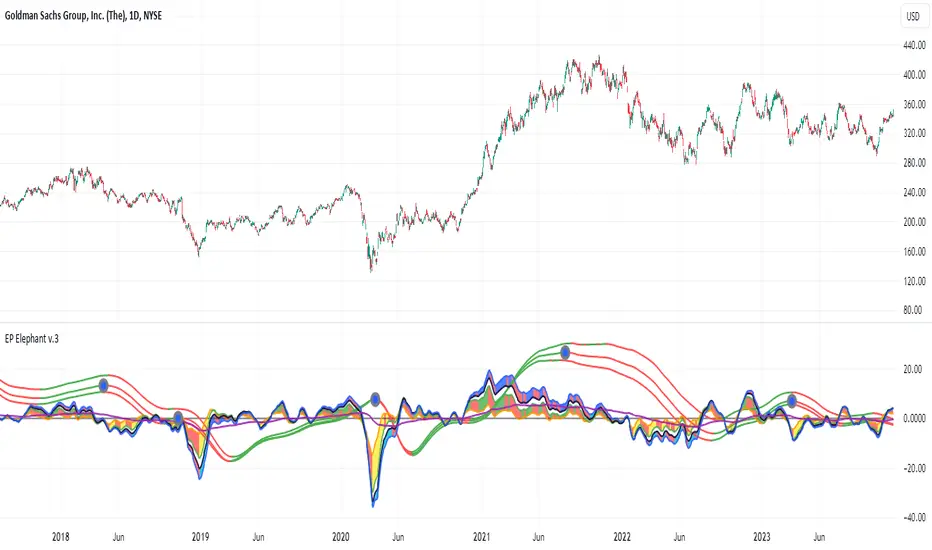EP Elephant Indicator

Longer averages were added, allowing to have a reference within the same timeframe of the short and long-term trend.
By adding the long socks, we also had the opportunity to discover new patterns, thus emerging the "Elephant" pattern, which finally gave the indicator its name.
The elephant pattern is made up of three elements:
1.- Eye of the elephant. At first, we manually drew the eye. In newer versions of the indicator the eye is drawn automatically.
2.- Tusk of the elephant. It is drawn by the fastest averages, showing a short-term uptrend. In a lateral or bullish trend it can be a good time to buy.
3.- Trunk of the elephant. It always follows the elephant's eye and tusk, and is made up of the longest stockings.
The logic of this pattern is clear: We always look to buy after a price drop, either during an uptrend or at the end of a steep decline.
When an eye appears, we always expect the later appearance of the tusk. If we want further confirmation, we should wait for the averages 1-4 (in black) and 1-5 (blue) to rise. The lifting of the longest averages (of the trunk) indicates the change in trend.
This method helps us control our impulses, always anticipating the ideal moment of purchase. It gives very good results both when it comes to "catching the bottom" of a fall and when it comes to joining an uptrend already formed.
Optionally, we can make the indicator draw signals in the areas of interest, and color the bottom of the indicator in these areas.
These signals must always be taken with caution, evaluating the price action, and visually confirming the complete appearance of the patterns. These signals by no means show all the buying zones, and can sometimes give false entries.
We can confirm the operations with the signals given by other indicators, such as the EP Zenith and EP Change Index, and we recommend always to be aware of the trend lines, supports and resistances.
There are different types of "Elephants" that should be known to get the most out of the indicator.
Elephant Indicator is highly effective in volatile assets, and should take its signals with much more caution in very flat lateral trends.
The approach of all its averages can be taken as an early sign of a more abrupt movement, as it can happen for example with Bollinger Bands. On the contrary, long averages very far from the rest indicate a greater risk of correction.
- Added a smoothed Average LT, to better reflect the longer-term trend.
- Options have been added to hide or show the different types of indicator averages. All stockings have their reason for being, but if you like a cleaner design you have the option to do so.
For alerts in Tradingview, you can use "Alert Line", program your alerts for values above 0. In this way, TradingView will notify you of the Elephant alerts.
It is made up of two pairs of averages, one fast and one slow, one long-lasting average and three very long-lasting averages.
The first pair of averages, the fast averages, follow the price movement more accurately.
The space between them is painted red when the averages are falling, and yellow or green when they are rising.
The second pair of averages, the slow ones, are based on averages of a slightly longer length.
The space between them is painted red when the averages are falling, and cyan or blue when they are rising.
The best entry opportunities usually occur in what we call the “tusk” of the elephant, in yellow: short ascending averages with the fastest average above the other.
Once an upward trend is established, we will see how the slow pair stands above the fast one. We will take advantage of the twists in the averages to join that trend.
EP ELEPHANT presents several typical patterns that can be used to take positions in the market. We list some of them:
TYPICAL ELEPHANT:
The elephant figure is shown complete:
Head, eye, descending trunk, tusk and ascending trunk.
REVERSAL CROSSING: Occurs after a sharp fall.
The averages cross the long one, fall and rise again, leaving a higher peak, and forming an easily recognizable pattern.
BULLISH ELEPHANT: After the appearance of a tusk, the averages are compressed, occupying a minimum space above the 0 line. The three longest averages end up coming out above all the others.
Script su invito
Solo gli utenti approvati dall'autore possono accedere a questo script. È necessario richiedere e ottenere l'autorizzazione per utilizzarlo. Tale autorizzazione viene solitamente concessa dopo il pagamento. Per ulteriori dettagli, seguire le istruzioni dell'autore riportate di seguito o contattare direttamente EP-Trading.
TradingView NON consiglia di acquistare o utilizzare uno script a meno che non si abbia piena fiducia nel suo autore e se ne comprenda il funzionamento. È inoltre possibile trovare alternative gratuite e open source nei nostri script della community.
Istruzioni dell'autore
Declinazione di responsabilità
Script su invito
Solo gli utenti approvati dall'autore possono accedere a questo script. È necessario richiedere e ottenere l'autorizzazione per utilizzarlo. Tale autorizzazione viene solitamente concessa dopo il pagamento. Per ulteriori dettagli, seguire le istruzioni dell'autore riportate di seguito o contattare direttamente EP-Trading.
TradingView NON consiglia di acquistare o utilizzare uno script a meno che non si abbia piena fiducia nel suo autore e se ne comprenda il funzionamento. È inoltre possibile trovare alternative gratuite e open source nei nostri script della community.